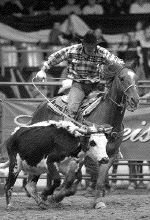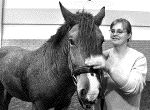A bit of country in the big city
From the Sharon Dunn |
| A bit of country in the big city Curly-haired horses, odd veggies and cowboys for all to see |
 [Photo: Peter Redman, National Post] MORE ENTERTAINING THAN VEGETABLES: A competitor tries his luck in the calf-roping event during the rodeo show.[TORONTO, ON] I just don’t get it. Maybe it’s me, but what is going on at the Royal Agricultural Winter Fair? First I go through a room with big vegetables — huge pumpkins, prize-winning carrots and other delights that I can’t even identify, and don’t want to. I try to get enthused, but frankly, edible agricultural products just don’t excite me, even big ones. Then I move on to the sheep room, where various piles of fleece are displayed, looking just like the lint from my dryer, only bigger. Some have ribbons on them, meaning they won, some don’t. It must have been fun judging these. Maybe if the fleece was in the form of a coat it could get a rise out of me, but not in this condition. There’s the popular rabbit room, with dozens of bunnies sitting in cages. Why are there so many, I wonder? Probably started the day with just two… I’m told there’s great food, so I wander over to an area that consists mainly of mall-type fast-food concessions — Chinese, pizza and the like. There is a fancy restaurant set up under a tent, with prices that would make a cowboy blush. When I walk by, all of the seats are empty. Cowboys have to win a lot of rodeos to be able to afford this place.There are lots of booths, but I can’t even get a fudge sample, “You have to buy,” I’m told. Why, that’s downright unneighbourly, especially if you don’t have a media pass and have to pay the $20 adult door fee ($15 for children).They’re selling everything here, like a giant flea market, from knick-knacks to music to vases. The only thing I got excited about was the National Post subscription booth. I’m not just saying this because I work here, they’re giving away black horsy-type blankets with every three-month subscription! I take out three subscriptions — for my lawyer, my mother and my sister, and they give me a fourth blanket by mistake. Of course, I keep it. Next I end up in the Cavalcade of Horses, where competitions are in full swing. A guy is riding around the arena holding a tray with a Champagne flute teetering atop (is he a waiter or a horseman?). But horses are the reason I’ve come here. I have brought my son Luke, who has allergies, to check out the so-called hypoallergenic horse, a Bashkir Curly, which has been bred to bring hope to horse-loving allergy sufferers. Bashkir Curlies have been around for a while: Napoleon, when he conquered Austria in 1805, found what he described as “poodle-hair horses” at the Vienna Zoo and had them transported back to France.”It’s been a pretty exciting week,” says owner Sonja Oakes of Sir Charles, the curly-haired horse she has brought to the fair. “A lot of people are coming to touch, feel, smell. They want to see if they’re going to have an allergic reaction to him.” And no one has, says Oakes proudly.  [Photo: Peter Redman, National Post] Sonja Oakes shows off Sir Charles, a Bashkir Curly horse. “We’ve had people from all over the world come to our farm [outside of Guelph] who are so allergic to horses they want a map to the hospital before they come. They arrive with their medical kit, (including an epi-pen for severe allergic reactions) and a change of clothes. The worst we’ve had is a runny nose.””How are you feeling?” I ask Luke.”Fine,” he says, “no allergies.” I, however, sneeze, and my nose starts to run, I can’t blame the curly, what with the hay and other horses and who knows what else in the air, Oakes says. Sonja and her husband, Greg, have the biggest collection of curlies in the country, with 45 of them on their ranch. I run into a cowboy named Richard Thompson who runs Horsemanship Clinics: “It’s the humans who need the training, not the horses,” he says. At the clinic he teaches people how to communicate and bond with their horse, and how to break bad habits.”When a horse nuzzles, you think it’s because he likes you,” says Thompson, but this isn’t so. “It’s because he’s a prey animal, and he knows if there’s danger he can knock you down and get away. He’s using you as a human shield.” The most important part of the Royal Winter Fair, I’m told, is the invaluable connections and friendships that are forged for future livestock sales. But it turns out the Royal is not the biggest agricultural fair in the country. Regina holds that distinction, mainly because it’s rural and Toronto isn’t. But some of us in the big city have an obvious great interest in vegetables and sheep fleece and hens and rabbits and rodeos and hogs, and everything country. Nothing wrong with that, of course, but you must admit it is a stretch in the big city. by Sharon Dunn |
